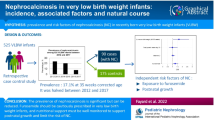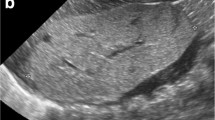Abstract
Background
The use of postnatal corticosteroids to treat or prevent chronic lung disease is common in very preterm infants. Medullary nephrocalcinosis has been noted as a possible side effect.
Objective
This prospective study was designed to assess the incidence of nephrocalcinosis in extremely preterm infants exposed to dexamethasone.
Patients and methods
A prospective study of extremely preterm infants, recruited to a randomized trial of dexamethasone treatment for chronic lung disease, was initiated. Infants had US of the renal tract scheduled on entry into the study, at day 28 and at discharge or at the corrected gestational age of 36 weeks.
Results
Thirty-three infants were enrolled in the study. Birth weight ranged between 440 and 990 g and gestation between 24 and 28 weeks. Nine infants died and six had incomplete data. Because there was no difference in incidence of calcification between those on the short course and those on the long course of dexamethasone, analysis was made on the entire cohort. One infant had nephrocalcinosis at the time of the initial US examination on day 26 of life. By day 28, nephrocalcinosis was present in 31% of those with complete data. By discharge, or corrected gestational age of 36 weeks, US evidence of nephrocalcinosis was present in 15 (83%) of 18 infants. All infants had at least one course of an aminoglycoside antibiotic during the study. All infants had parenteral nutrition. Only four infants received furosemide more regularly than single doses. The longest course was 10 days, received by an infant who did not develop nephrocalcinosis.
Conclusion
The incidence of nephrocalcinosis is high in this group of sick, extremely preterm infants. Dexamethasone may be a factor in the development of nephrocalcinosis. Future research should focus on the natural history of nephrocalcinosis in extremely preterm infants.




Similar content being viewed by others
References
Hoppe B. Duran I, Martin A, et al (2002) Nephrocalcinosis in preterm infants: a single center experience. Pediatr Nephrol 17:264–268
Kamitsuka MD, Williams MA, Nyberg DA, et al (1995) Renal calcification: a complication of dexamethasone therapy in preterm infants with bronchopulmonary dysplasia. J Perinatol 15:359–363
Narendra A, White MP, Rolton HA, et al (2001) Nephrocalcinosis in preterm babies. Arch Dis Child Fetal Neonatal Ed 85:F207-F213
Hufnagle KG, Khan SN, Penn D, et al (1982) Renal calcifications: a complication of long-term furosemide therapy in preterm infants. Pediatrics 70:360–363
Short A, Cooke RW (1991) The incidence of renal calcification in preterm infants. Arch Dis Child 66:412–417
Jacinto JS, Modanlou HD, Crade M, et al (1988) Renal calcification in very low birth weight infants. Pediatrics 81:31–35
Odd DE, Armstrong DL, Teele RL, et al (2003) A randomized trial of two dexamethasone regimens to prevent chronic lung disease of prematurity. J Paediatr Child Health (in press)
Campfield T, Braden G (1989) Urinary oxalate excretion by very low birth weight infants receiving parenteral nutrition. Pediatrics 84:860–863
Hoppe B, Hesse A, Neuhous T, et al (1993) Urinary saturation and nephrocalcinosis in preterm infants: effect of parenteral nutrition. Arch Dis Child 69:299–303
Rockwell GF, Campfield T, Nelson BC, et al (1998) Oxalogenesis in parenteral nutrition solution components. Nutrition 14:836–839
Halliday HL, Ehrenkranz RA (2001) Moderately early (7–14 days) postnatal corticosteroids for preventing chronic lung disease in preterm infants. Cochrane Database Syst Rev 1:CD001144
Barrington KJ (2001) The adverse neuro-developmental effects of postnatal steroids in the preterm infant: a systematic review of RCTs. BMC Pediatr 1:1–9
Sonntag J, Gaude M (1998) Effect of dexamethasone and spironolactone therapy in calcium and phosphate homeostasis in premature infants with a birth weight under 1500 g. Klin Padiatr 210:354–357
Patriquin H, Robitaille P (1986) Renal calcium deposition in children: sonographic demonstration of the Anderson-Carr progression. AJR 146:1253–1256
Cramer B, Husa L, Pushpanathan C (1998) Nephrocalcinosis in rabbits: correlation of ultrasound, computed tomography, pathology and renal function. Pediatr Radiol 28:9–13
Awad H, el-Safty I, el-Barbary M, et al (2002) Evaluation of renal glomerular and tubular functional and structural integrity in neonates. Am J Med Sci 324:261–266
Aperia A, Broberger O, Broberger U, et al (1983) Glomerular tubular balance in preterm and full term infants. Acta Paediatr Scand Suppl 305:70–76
Gallini F, Maggio L, Romagnoli C, et al (2000) Progression of renal function in preterm neonates with gestational age <or = 32 weeks. Pediatr Nephrol 15:119–124
Ralston SH, Fraser WD, Jankowski J, et al (1990) Hypercalcaemia in rheumatoid arthritis revisited. Ann Rheum Dis 49:22–24
Jones CA, King S, Shaw NJ, et al (1997) Renal calcification in pre-term infants: follow up at 4–5years. Arch Dis Child Fetal Neonatal Ed 76:F185–189
Pope JC, Trusler LA, Klein AM, et al (1996) The natural history of nephrocalcinosis in premature infants treated with loop diuretics. J Urol 156:709–712
Saarela T, Vaarala, A, Lanning P, et al (1999) Incidence, ultrasonic patterns and resolution of nephrocalcinosis in very low birth weight infants. Acta Paediatr 88:655–660
Ronnefarth G, Misselwitz J (2000) Nephrocalcinosis in children: a retrospective study. Members of the Arbeitsgemeinschaft fur padiatrische Nephrologie. Pediatr Nephrol 14:1016–1021
Author information
Authors and Affiliations
Corresponding author
Additional information
Presented at the 40th Annual Congress of ESPR, Genoa, Italy, June 2003
Rights and permissions
About this article
Cite this article
Cranefield, D.J., Odd, D.E., Harding, J.E. et al. High incidence of nephrocalcinosis in extremely preterm infants treated with dexamethasone. Pediatr Radiol 34, 138–142 (2004). https://doi.org/10.1007/s00247-003-1090-7
Received:
Revised:
Accepted:
Published:
Issue Date:
DOI: https://doi.org/10.1007/s00247-003-1090-7




